

Team members
Kenneth Sim Jian Hui (ISTD), Lim Cheng Le Gerald (EPD), Keane Lim Teck Meng (EPD), Oh Huan Xuan (ISTD), Shruthi Pandi Chelvam (EPD), Chelsea Foo Shu Qi (ISTD)
Instructors:
Writing Instructors:
Teaching Assistant:

Post-Concussion Syndrome or Symptoms (PCS), is much more common than many may know. PCS is when concussion symptoms continue for months or years after an initial concussion or brain injury. Many times patients go a long time without much hope or support when living with PCS.
Symptoms may evolve over time and appear to be caused by something other than the concussion or mild Traumatic Brain Injury (mTBI). Many times doctors look in other places as the source of the symptoms, other than the brain.
Symptoms can be broken up into four different categories, Emotional, Physical, Cognitive, and Sleep. PCS impacts many, if not all, areas of life, including quality of life. Emotional symptoms can include depression and anxiety, and can easily be confused with other mental health conditions.
Founded in 2014, Cognitive FX (CFX) focuses on setting the standard of care for patients who struggle with long-term concussion symptoms or PCS. Thus far, they have treated over 1500 patients and even in the wake of COVID-19, they continue to explore methods to continue to provide quality care and treatment for their patients.
CFX utilises cutting-edge brain scan technology called functional Neurocognitive Imaging (fNCI) which can reliably detect which regions of the brain are affected from your concussion or brain injury and to guide their treatment. Patients will undergo two scans one before and one after their in their specialised Enhanced Performance in Cognition (EPIC) treatment, one before and one after.
EPIC treatment is a week-long program designed to effectively treat Post-Concussion Syndrome or Symptoms, using it uses the results of the fNCI scan to specially tailor activities to help increase the effectiveness of the treatment the patient receives.
Facing constraints due toissues with COVID-19, we had to adapt to the situation and revamp the idea to make it applicable in these times. In doing so, we looked at how we could improve the post-EPIC treatment that the company provides. Our project aims to create creating a tailored solution that improves the quality and accessibility of the multidisciplinary therapy activities that patients can utilize from the comfort of their homes. The solution would also have to be capable of customization based on therapists recommendations. Hence our problem statement was as follows, “To design a complementary take-home solution that improves the quality and accessibility of activities for patients and reduces the workload of therapists, in the wake of a post-COVID19 new normal”.
Our solution consists of 3 main systems: Therapist web platform, patient’s tablet program, and a physical pressure mat. The web platform is intended for therapists’ use to administer activities to patients based on their fNCI scans and progress with other activities. The tablet program combined with the mat houses all possible activities that the patients will be able to do - some of which will be recommended by the therapists.
As we recognise that each patient is different from one another, we created the Therapist Web Platform to suit that need. Hosted on the cloud, it allows the therapist to monitor activities made by patients and alter their activity parameters, entirely at the therapist’s convenience. We protected our database and systems against most common cyber attacks to ensure that patient data is safe and secure.
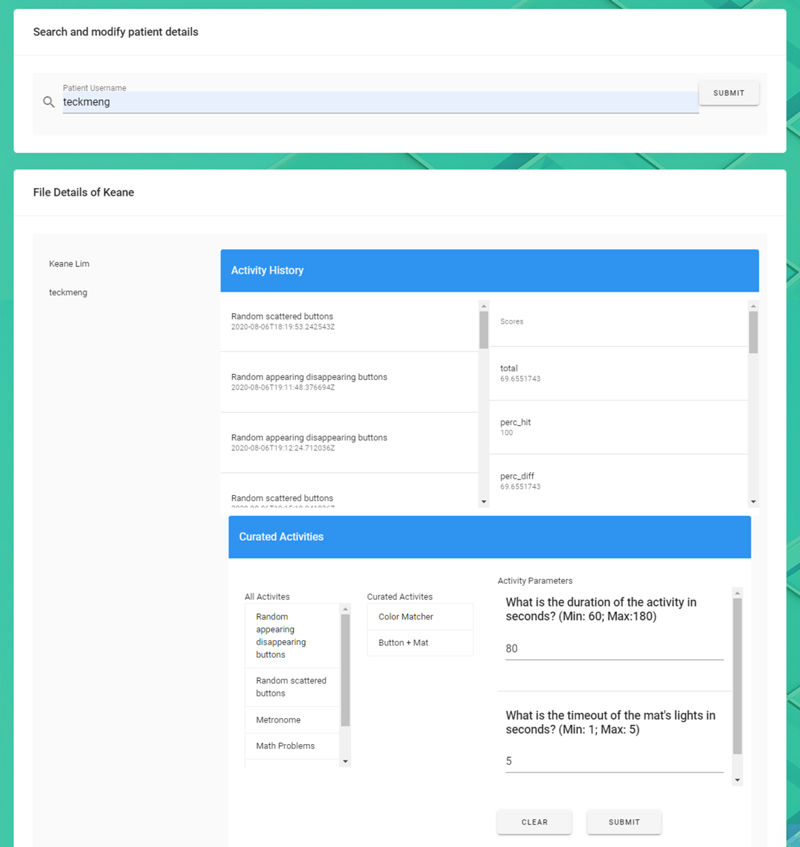
The Patient Tablet Program was created for the iPad. It consists of a user interface which allows the patient to perform all the activities as well as view their progress and activity history through the application. It tracks user progress and key points of their behaviour before passing the numbers through a customised algorithm to determine patient progress across time.
iPad User Interface
The iPad User Interface acts as a hub for the patients to access activities on their own, as well as complete activities prescribed by the therapists. Each activity consists of customisable parameters that can be controlled and assigned on the Therapist Web Platform by their personal therapists. Patients are able to view and complete the activities prescribed to them. If the patient wants to practice by completing their activities, they can choose the parameters before starting the activity.
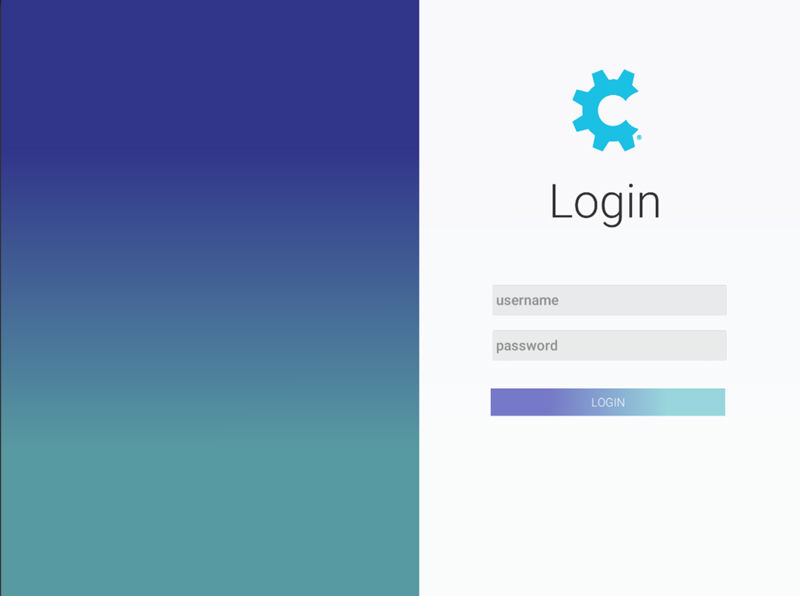
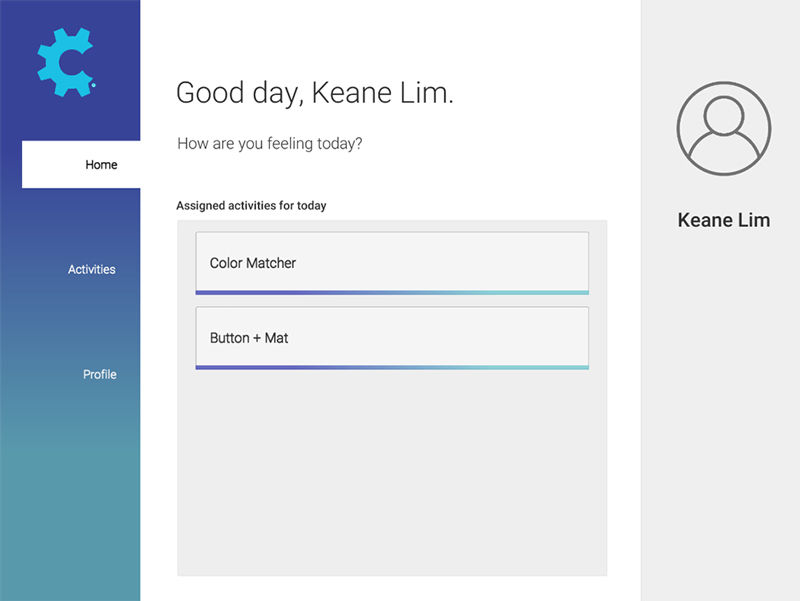
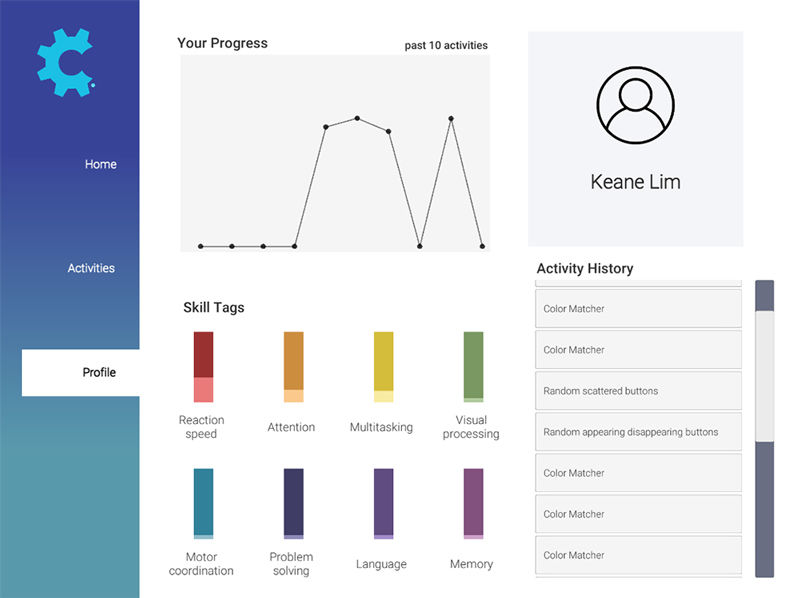
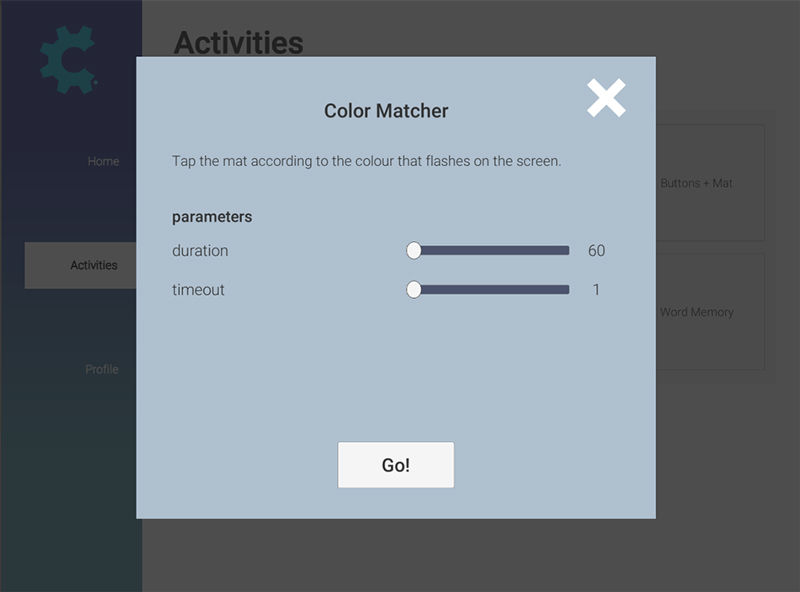
Patients will have access to 8 activities that target different skill tags. These activities vary from iPad only activities to iPad and Mat activities. Examples of the iPad only activities include activities like the Metronome and Sustained Math Problems. The Mat and iPad activities will be the Button activity with the Colour Mat(cher) activity.
iPad-only activity 1: Random appearing disappearing buttons

iPad-only activity 2: Metronome activity
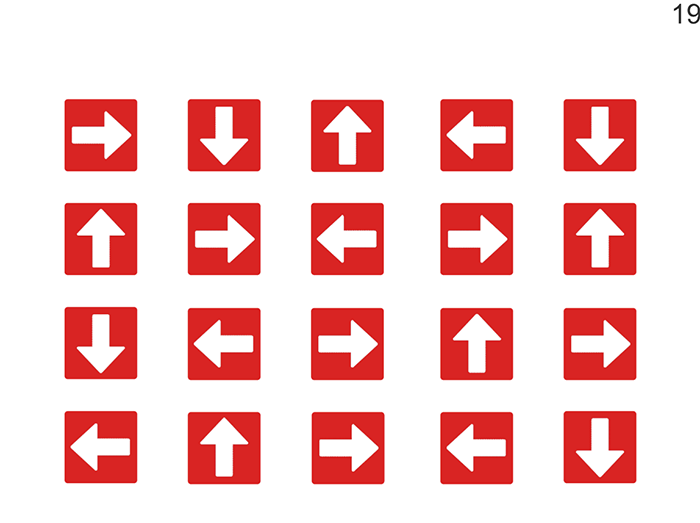
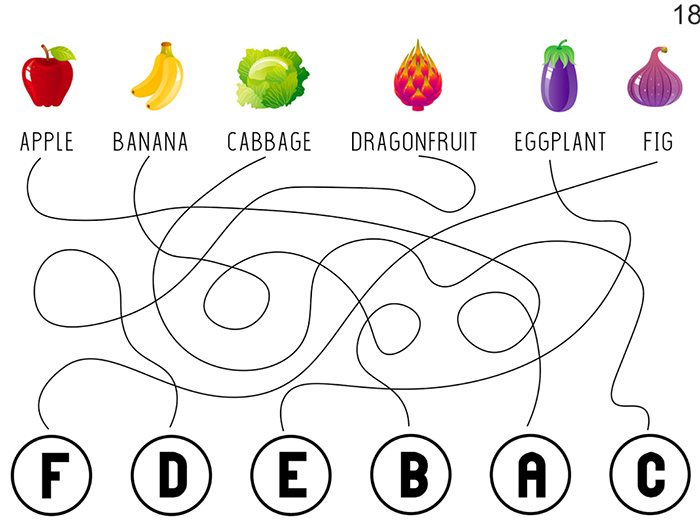
The physical pressure mat consists of a 3 by 3 grid layout with the middle grid deemed as a resting grid for patients to position themselves on prior to the start of the activity. 3 activities can be played using the mat:
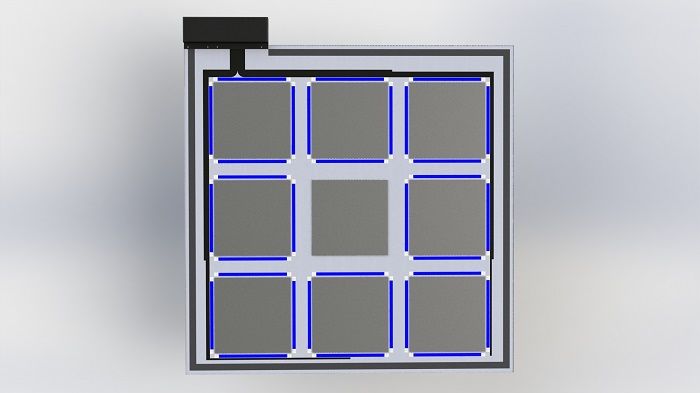
Activity 1: Whack-a-Colour
Random colours will flash on the user’s iPad screen and the corresponding colour lights up along a random grid on the mat. Users would need to step on the appropriate grid.
Activity 2: Colour Matcher
LEDs along all grids would light up and random colours would flash on the user’s iPad screen. Users would have to step the corresponding colour on the mat.
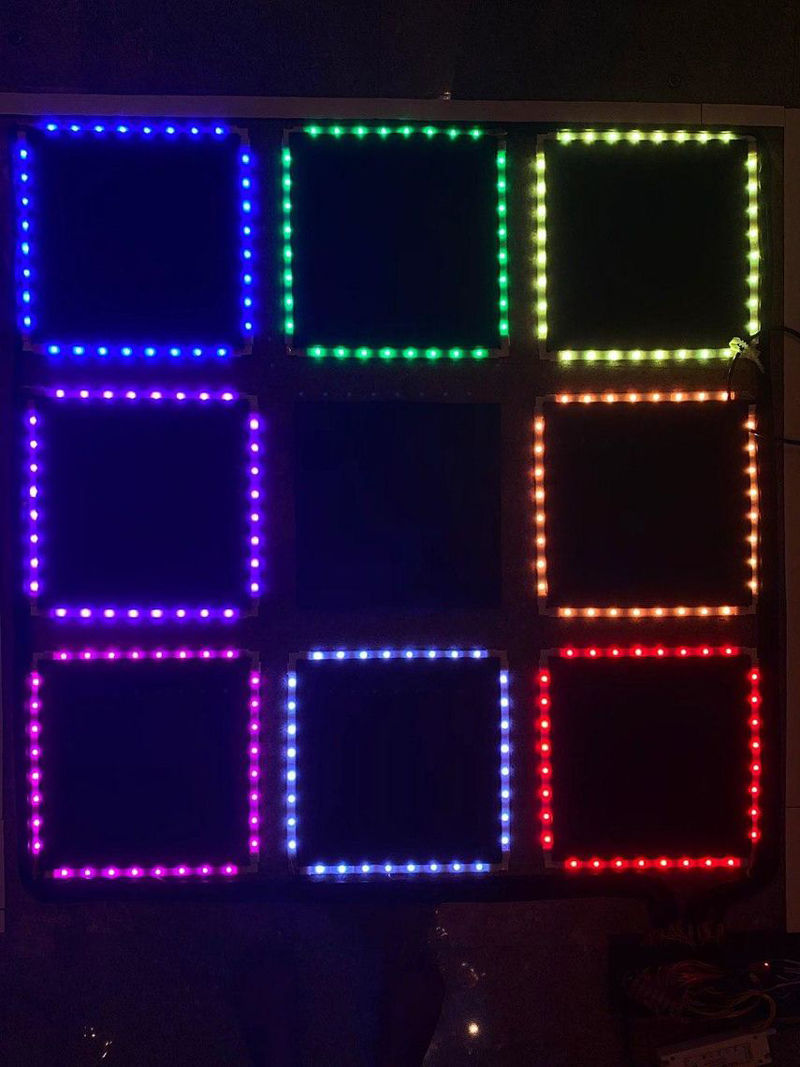
Activity 3: Tap n Tap
Played in conjunction with the button activity, where users would have to step on the grid that has the same colour as the button being pressed.
Operating Mechanism:
To perform these activities, the mat consists of 3 subsystems namely; Grid, LED and Casing. Each grid except the middle, has a variable resistor known as Velostat. This sheet sensor varies in resistance based on the amount of pressure placed on it. Thin aluminium sheets are used on both sides to act as conductive layers and sandwich the velostat. A layer of foam is placed above the Velostat, to provide user comfort as the patients step on the grids and to also ensure that the velostat and aluminium sheets are protected from damage.
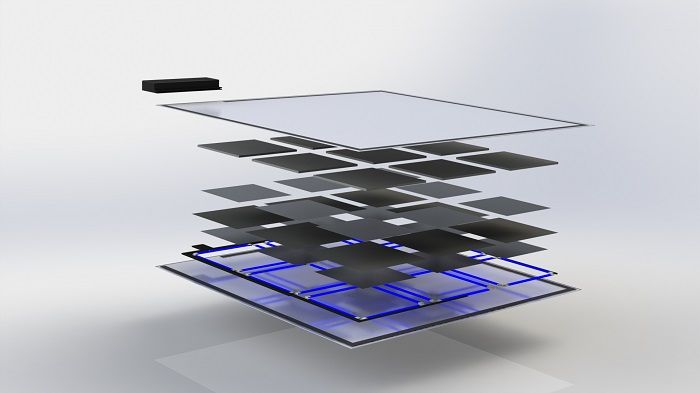
Each grid is surrounded by an array of WS 2812B LEDs as part of the LED subsystem. The communication between the LEDs and Velostat during the above mentioned activities is done via integration between Unity and Arduino via a HM-10 Bluetooth Module. The colour in which the LEDs will be turned on for a grid is specified by Unity. Should the patient step on the appropriate grid and the threshold is exceeded, the respective LED strip will turn off. If the patient does not step on the grid or doesn’t not exert enough force, the LEDs will remain on.
Wiring from the LEDs and Velostat in each grid runs along the sides of the mat to the Casing subsystem in which all electronic components are housed. The casing was 3D printed with PLA to simulate the plastic material that will house the components that would be used
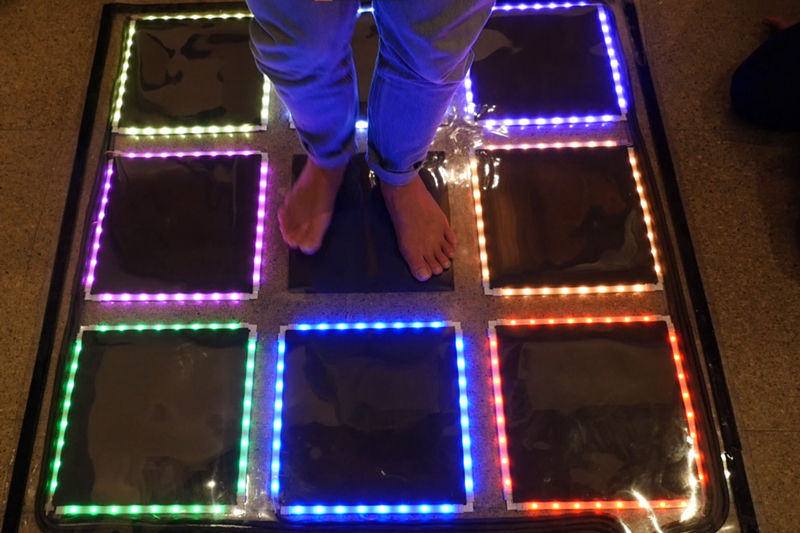
Casing Subsystem
Wiring from the LEDs and Velostat in each grid runs along the sides of the mat to the Casing subsystem in which all electronic components are housed. The casing was 3D printed with PLA to simulate the plastic material that will house the components that would be made using plastic moulding. The casing is secured to the mat via a clamping method with nuts and bolts.
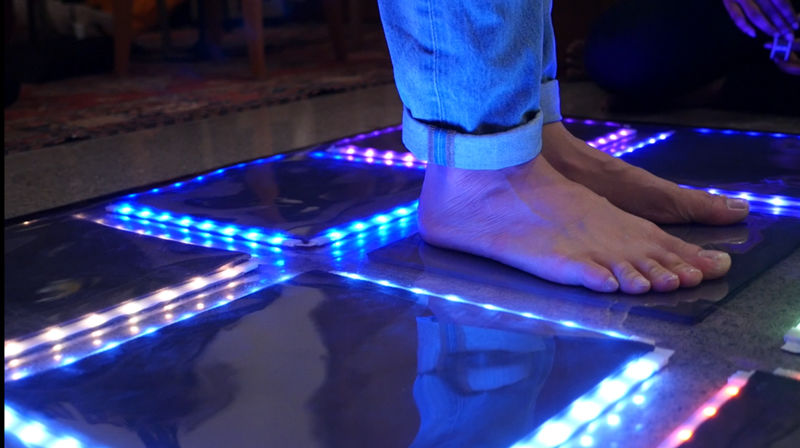
Sealing Method
We opted for a velcro seal that allows for customization of the mat and allows for easy troubleshooting. Though it was initially planned for the mat to be sewn, there was a concern that outsourcing the sewing may result in damage to the internal components. However, with the use of industrial manufacturing methods, the components will be more reliable, allowing a more permanent sealing method to be adopted, such as sewing of the mats.
Power Supply
As the LEDs have a fairly large power draw of 72W, sourcing a battery was challenging as we needed to find one that fit the specific requirements for our project. Hence we opted for a LED driver power supply that is wired which supplies power to the LED, Arduino, and Bluetooth Breakout.
We would like to thank Prof Wei Lek and Prof Liu Jun for their continued support and advice during the Capstone period, especially through the uncertainties brought about by COVID-19. Additionally, we would like to thank Rachel, for providing feedback and comments on the various ways we can improve our writings and presentations. Last but not least, without whom this project would not have started, Jordan. Who was always quick with the replies despite the time difference, always calling us with a cheerful smile, handling the project on top of all the changes ongoing in the clinic, and being understanding when the solution had to change due to COVID-19.
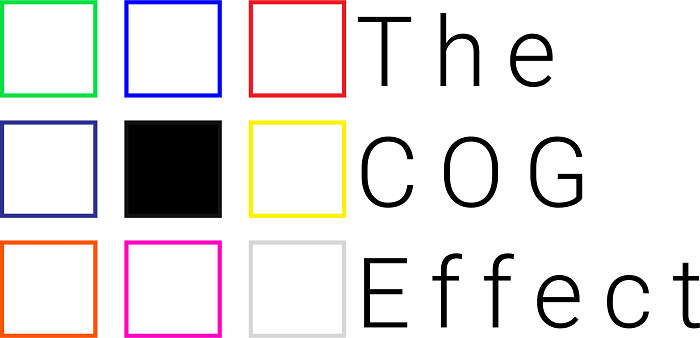
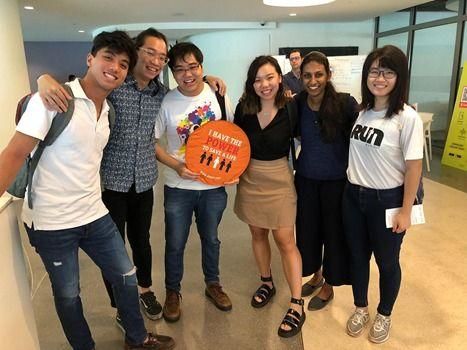
 Kenneth Sim Jian Hui
Information Systems Technology and Design
Kenneth Sim Jian Hui
Information Systems Technology and Design
 Lim Cheng Le Gerald
Engineering Product Development
Lim Cheng Le Gerald
Engineering Product Development
 Keane Lim Teck Meng
Engineering Product Development
Keane Lim Teck Meng
Engineering Product Development
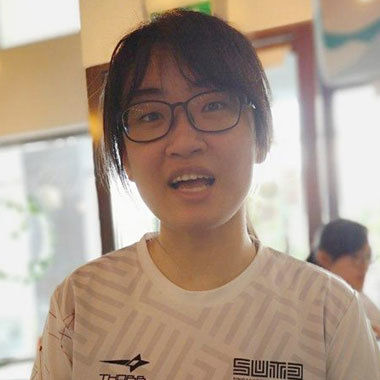 Oh Huan Xuan
Information Systems Technology and Design
Oh Huan Xuan
Information Systems Technology and Design
 Shruthi Pandi Chelvam
Engineering Product Development
Shruthi Pandi Chelvam
Engineering Product Development
 Chelsea Foo Shu Qi
Information Systems Technology and Design
Chelsea Foo Shu Qi
Information Systems Technology and Design

Kenneth Sim Jian Hui
Information Systems Technology and Design

Lim Cheng Le Gerald
Engineering Product Development

Keane Lim Teck Meng
Engineering Product Development

Oh Huan Xuan
Information Systems Technology and Design

Shruthi Pandi Chelvam
Engineering Product Development

Chelsea Foo Shu Qi
Information Systems Technology and Design
© 2020 SUTD

